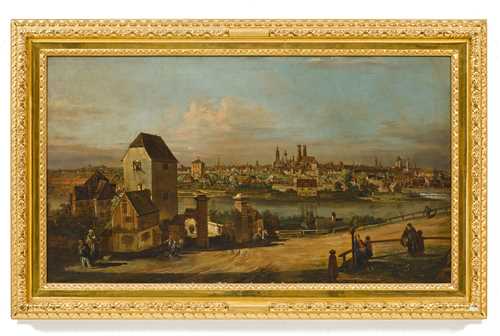
Lot 3062* - A198 Tableaux de Maîtres Anciens - vendredi, 01. octobre 2021, 14h00
BERNARDO BELLOTTO called CANALETTO and LORENZO BELLOTTO
– Collection of the Austrian Consul General Wünsch (born circa 1780).
– Collection of his daughter, Mrs. Jiricek-Wünsch (1818–1859).
– Via inheritance, collection of her husband, Leopold Zdeborsky (1815–1887), Prague (wax seal verso).
– Collection of his daughter, Sofie-Johanna Honsig von Jägerhain, Austria (daughter of Leopold and Johanna Zdeborsky, married to Julius Anton Honsig von Jägerhain).
– Collection of Julius Anton Honsig von Jägerhain (1849–1924).
– Collection of Ing. Heinrich Honsig, brother of Julius Anton Honsig von Jägerhain.
– With Sabin, London (via Karl Honsig, nephew and heir of Heinrich Honsig).
– With Karl Haberstock, Berlin, 1928.
– Maser Collection, Zurich, 1936.
– Heinrich Abel Collection, Munich, 1997.
– European private collection, since 2000.
Exhibited:
Vienna 2005, Bernardo Bellotto genannt Canaletto. Europäische Veduten, Kunsthistorisches Museum Vienna, 16.3.–19.6.2005, no. 30.
Literature:
- Most likely exh. cat. Bernardo Bellotto genannt Canaletto, Vienna 1965, p. 69.
- Andrzej Rottermund: Bernardo Bellotto's Unknown View of Munich, Artibus et Historiae, no. 38, 1998, pp. 9–20.
- Bernardo Bellotto and the Capitals of Europe, exh. cat. Edgar Peters Bowron (ed.), New Haven / London 2001, p. 214.
- Karl Schütz: Bernardo Belotto, gen. Canaletto - Leben und Werk, Vernissage, no. 2/2005, pp. 6–23 (p. 13, ill.).
- Exh. cat. Bernardo Bellotto genannt Canaletto. Europäische Veduten, (ed.) W. Seipel, Vienna 2005, cat. no. 30, pp. 152–153.
- Charles Beddington: Munich from Gasteig Hill, in: Selected Old Master Paintings, London 2011, pp. 54–55 (with ill.).
- Exh. cat. Canaletto – Bernardo Bellotto malt Europa, (ed.) Andreas Schumacher, Munich 2014, p. 254.
This rare view of Munich as seen from Gasteig Hill was discovered recently in a private collection and published by A. Rottermund as the third version of Bernardo Bellotto's famous composition in the artist’s own hand (see Literature). The first version is in the Bayerische Staatsgemäldesammlungen, Munich Residenz (inv. no. 111, dated 1761, oil on canvas, 125 x 220 cm) and a replica, on which it is assumed his son Lorenzo Bellotto (1742–1770) also worked, is now in the National Gallery of Art in Washington (Samuel H. Kress Foundation).
Bernardo Bellotto travelled from Vienna to Munich in 1761 and arrived there on 14 January with a letter of recommendation from Maria Theresa of Austria to Princess Maria Antonia Walpurgis Symphorosa of Bavaria (see H. A. Fritzsche: Bernardo Bellotto genannt Canaletto, Burg b. Magdeburg 1936, pp. 68–70). Princess Maria Antonia of Bavaria was the sister of the Bavarian Elector and married to Frederick Christian Elector of Saxony, the eldest son and heir to the throne of Frederick August II. The couple were residing at the Munich court because of the Seven Years War. Bellotto painted for Maximilian III. Joseph Elector of Bavaria a large view of Munich and two of the summer residence at Nymphenburg, which are still in the Electoral Residence in Munich today. Gisela Barche surmises on the basis of the Bavarian and Saxon coat of arms, common to the original frames of the three paintings, that this was not a commission from the Bavarian Elector, but rather a gift from the Saxon princely couple to their hosts (see Gisela Barche: Bernardo Bellotto, Verona e le citta europee, Verona 1990, pp. 156–161).
Bellotto made replicas of these three views of about half the original size, two of which (View of Munich and a View of Nymphenburg) are now in the National Gallery of Art in Washington. According to Rottermund, the third known version of the View of Munich offered here, was probably made between 1762 and 1767, that is, after the artist's return to Dresden, and is comparable in size to the version in the National Gallery of Art. During this period, commissions from the royal court decreased due to the death of King August III in Dresden, so Bellotto had to accept additional commissions. In addition, it is known that Bellotto, who was already working as a 14-year-old in the workshop of his uncle, the famous Venetian painter of vedute, Giovanni Antonio Canale called Canaletto (1697–1768), made numerous detailed drawings as preparation for his large compositions. He was thus able to have recourse to these preparatory drawings for later commissions and make replicas. In our version, Andrzej Rottermund and Charles Beddington consider it possible that Bellotto's son Lorenzo contributed to the city view in the background, while Karl Schütz sees this as the exclusive work of Bernardo Bellotto (see Literature). The large-format copperplate engraving made in 1766 by Franz Xaver Jungwirth (1720–1790) seems, judging by the staffage, to be based on one of the two replicas, rather than on the first version in the Munich Residenz.
On the reverse of our painting, a label and a wax seal with the inscription "Prague" and the name "Leopold Zdeborsky" refer to the former owner Leopold Zdeborsky (1815–1887), who lived in Prague. Around 1840 he married Jiricek-Wünsch (1818–1859), who was the daughter of Consul General Wünsch (born 1780).
CHF 0 / 0 | (€ 0 / 0)
Vendu pour CHF 603 300 (frais inclus)
Aucune responsabilité n'est prise quant à l´exactitude de ces informations.


